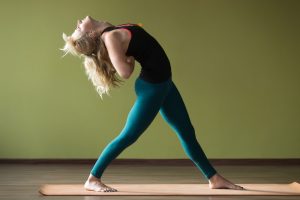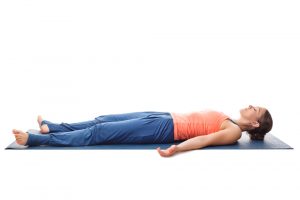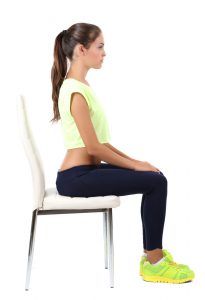Yoga May Help Ease Stiffness, Poor Balance Associated with Parkinson’s Disease: Here’s How

Yoga has been shown to increase flexibility and posture, ease stiffness, and improve balance through the strengthening of core muscles in patients with Parkinson’s disease.
Kaitlyn P. Roland, PhD, a yoga teacher at the Parkingo Wellness Society in Victoria, Canada, and a specialist in studies of the rehabilitative needs of people with Parkinson’s disease, demonstrated which yoga poses are best for Parkinson’s patients and why.
The following five poses are described in the article, “The Power of Poses: Yoga may help ease symptoms of Parkinson’s disease, such as stiffness and poor balance,” published in the journal Neurology Now, an official publication of the American Academy of Neurology (AAN).
Three-Part Breath
“Sit comfortably on a chair with your feet flat on the floor directly under your knees and your hands resting on your knees. Notice your natural breathing. Place your hands on your abdomen and take a few deep breaths. Feel your stomach soften with each exhale. Move your hands to your rib cage and inhale to expand the ribs. Exhale and allow the ribs to soften and the stomach to relax. Repeat three times, then place one hand on your abdomen and the other on your chest. Inhale into the abdomen, then the ribs, then the chest. Exhale, allowing your chest to relax, the ribs to come in, and the stomach to soften. Repeat three or more times,” Roland writes in the article.
“Slowing down and deepening the breath calms the nervous system and is especially good for anxiety and depression,” she said.
Mountain Pose
 “Stand with your feet hip-width apart and your back to a wall. If your heels don’t easily reach the wall, keep them slightly forward. As you improve, move the heels toward the wall. Press into your toes and heels at once to engage the arches of your feet. Draw your belly button in toward your spine and slightly up toward your ribs. Gently press the backs of your hips, lower ribs, shoulder blades, and head into the wall. Keep your head in line with your spine and tuck your chin slightly,” Roland writes.
“Stand with your feet hip-width apart and your back to a wall. If your heels don’t easily reach the wall, keep them slightly forward. As you improve, move the heels toward the wall. Press into your toes and heels at once to engage the arches of your feet. Draw your belly button in toward your spine and slightly up toward your ribs. Gently press the backs of your hips, lower ribs, shoulder blades, and head into the wall. Keep your head in line with your spine and tuck your chin slightly,” Roland writes.
“Stooping is common in Parkinson’s disease due to changes in muscle strength and balance. Becoming more aware of posture and strengthening the muscles that hold the body upright improve walking, balance, and even digestion,” she adds.
Modified Boat Pose
 “Sit on the front edge of a straight-backed chair and put your hands on the sides of the chair. Draw your belly button in and slightly up toward your ribs. Lean back and engage your stomach muscles. Raise your right arm while lifting your right foot off the floor. Repeat on the other side, then lift both arms and feet together,” Roland says.
“Sit on the front edge of a straight-backed chair and put your hands on the sides of the chair. Draw your belly button in and slightly up toward your ribs. Lean back and engage your stomach muscles. Raise your right arm while lifting your right foot off the floor. Repeat on the other side, then lift both arms and feet together,” Roland says.
“Strengthening the back and stomach muscles makes it easier to move from one place to another, such as getting out of bed or standing up from a chair,” she writes.
Warrior 1 Variation
 “Stand with your feet hip-width apart. Step your right foot back about three feet, keeping feet and hips facing forward, and bend your front knee slightly. Inhale and lift your arms overhead, then exhale and move them behind you as if to place them in a back pocket. Press into your feet and engage your leg muscles. Press your hands into your hips and draw your elbows together behind you. Lift your chest and gaze toward where the wall meets the ceiling. Inhale and step your right foot forward and bring your arms back to your sides. Step your left foot back and repeat on the opposite side,” Roland explains.
“Stand with your feet hip-width apart. Step your right foot back about three feet, keeping feet and hips facing forward, and bend your front knee slightly. Inhale and lift your arms overhead, then exhale and move them behind you as if to place them in a back pocket. Press into your feet and engage your leg muscles. Press your hands into your hips and draw your elbows together behind you. Lift your chest and gaze toward where the wall meets the ceiling. Inhale and step your right foot forward and bring your arms back to your sides. Step your left foot back and repeat on the opposite side,” Roland explains.
“This pose is great for balance and opening the chest. It should make you feel like you have a strong foundation and an open heart,” she added.
Relaxation Pose
 “Lie on your back with your lower legs resting on a chair or extended over a cushion under your knees to create a natural curve in the lower back. Rest your hands on the floor by your side and let your feet relax naturally. Place eye bags or light sandbag weights — or ask your instructor to place them — on your thighs, ankles, upper arms, and wrists. (You can make your own sandbag weights with uncooked grains of rice in a Ziploc bag.) Close your eyes and let your whole body release into the floor. Allow your lips to part and your eyes to relax. Rest for three to five minutes,” she says.
“Lie on your back with your lower legs resting on a chair or extended over a cushion under your knees to create a natural curve in the lower back. Rest your hands on the floor by your side and let your feet relax naturally. Place eye bags or light sandbag weights — or ask your instructor to place them — on your thighs, ankles, upper arms, and wrists. (You can make your own sandbag weights with uncooked grains of rice in a Ziploc bag.) Close your eyes and let your whole body release into the floor. Allow your lips to part and your eyes to relax. Rest for three to five minutes,” she says.
“Relaxing helps calm the nervous system. For those who have tremors, placing light weights on the body can help create a deeper relaxation in those muscles. Fully resting is just as important as mindful exercise and movement,” Roland adds.
Roland wrote a brief informative piece about the effects of yoga on Parkinson’s for the Michael J. Fox Foundation in July 2015. In that piece, she explained how yoga might help improve mobility, balance, strength, flexibility, mood, and sleep, and you can read it to find out more about yoga and its effects.
Roland offers yoga workshops to Parkinson’s patients, called Yogadopa, and blogs about the condition, aging, and yoga-related issues at Yogadopa. If you think yoga might be good for you, talk with your doctor before starting any exercise program and look for a certified teacher. Both Yogadopa and Yoga Alliance might help you find a certified yoga teacher nearby.







